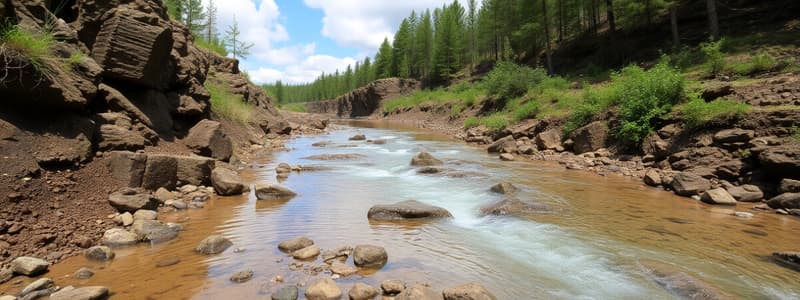Podcast
Questions and Answers
Flashcards
Bounded Water
Bounded Water
Water strongly held to soil particles or rock surfaces due to electrostatic forces.
Hygroscopic Water
Hygroscopic Water
Bounded water that fills microscopic spaces and irregularities on particle surfaces by adsorption.
Pellicular Water
Pellicular Water
A thin film of bounded water surrounding soil particles or rock surfaces.
Capillary Water
Capillary Water
Signup and view all the flashcards
Isolated Capillary Water
Isolated Capillary Water
Signup and view all the flashcards
Continuous Capillary Water
Continuous Capillary Water
Signup and view all the flashcards
Free or Gravitational Water
Free or Gravitational Water
Signup and view all the flashcards
Unsaturated Zone
Unsaturated Zone
Signup and view all the flashcards
Saturated Zone
Saturated Zone
Signup and view all the flashcards
Zone of Isolated Pores and Chemically Combined Water
Zone of Isolated Pores and Chemically Combined Water
Signup and view all the flashcards
Volumetric Water Content (θ)
Volumetric Water Content (θ)
Signup and view all the flashcards
Saturated Volumetric Water Content
Saturated Volumetric Water Content
Signup and view all the flashcards
Unsaturated Volumetric Water Content
Unsaturated Volumetric Water Content
Signup and view all the flashcards
Study Notes
Surface Water Hydrology and Advanced Hydrogeology
- This course note covers advanced hydrogeology.
- The instructor is Sileshi Mamo (PhD).
- The course notes were generated in 2018.
Types of Water in Soils/Rocks
- Water in soils and rocks is categorized into different types based on the forces holding it.
Bounded or Retained Water
- This is water fixed to soil particles or rock matrix.
- Two types of retained water include:
- Hygroscopic water: Fills pores and irregularities in particle surfaces through adsorption.
- Pellicular water: Forms a thin film around particles; it moves from denser to thinner films.
Capillary Water
- This is water that partially or completely fills soil and rock pores or sub-capillary channels.
- It's driven by capillary forces from surface tension.
- Two types of capillary water include:
- Isolated or perched capillary water: Located above the water table; cannot be removed by gravity.
- Continuous or sustained capillary water: Located in capillary fringe; influenced by gravity.
Free or Groundwater
- This water is not affected by attraction forces.
- It moves by gravity and is subjected to hydrostatic pressure.
- This is the most active part of groundwater.
Distribution of Subsurface Water
- Zones of subsurface water include:
- Unsaturated (vadose or aeration) zone.
- Saturated (phreatic or groundwater) zone.
- Zone of isolated pores and chemically combined water zone.
Water Content
- Volumetric water content (θ) is the fraction of space filled by water in a given volume.
- θ = Vw/Vt, where Vw is the volume of water, and Vt is the total volume.
- If pores are saturated with water, θ = n (porosity). If not, θ < n.
- Field capacity is the maximum volume of water retained by the soil against gravity.
Unsaturated Zone
- Occupies the region between the ground surface and the water table.
- Subdivisions include soil water zone, intermediate zone, and capillary fringe.
Soil Water Zone
- Extends between the ground surface and plant root zones.
- It can extend up to 10m.
- Affected by climate change, evaporation, and transpiration.
- Essential for plant life and growth.
- Water content varies based on wet or dry periods.
- Can reach the wilting point in dry periods.
- Fluid pressure head is negative, with pressure less than atmospheric pressure.
Intermediate Zone
- Extends from the lower soil water zone to the upper capillary zone.
- Thickness varies from zero to greater than 100m (depending on water table depth).
- Not directly affected by climate.
- Water moves downward under gravity.
- Water content is close to field capacity during dry periods and higher during wet periods.
- Negative pressure head (less than atmospheric pressure)
Capillary Fringe
- Present only in fine-grained soils.
- Extends from the water table up to a limit of capillary rise.
- Capillary rise depends inversely on the grain size of the sediments.
- Capillary rise can be up to 3m below ground surface.
- Water content increases from the upper to the lower part.
- The pressure is less than atmospheric due to surface tension.
Zone of Saturation/Groundwater
- All spaces in soils and rocks are filled with water.
- A portion of water drains under gravity.
- The zone extends from the top surface of the water table to an impermeable rock.
- The water table is the upper surface when there is no overlaying impermeable stratum.
- The water level in a well penetrating an unconfined aquifer is equal to atmospheric pressure.
- Below the water table, pressure is greater than atmospheric and increases with depth.
- The depth of the groundwater zone varies in sedimentary rocks from shallow to deep.
Zone of Isolated Pores and Chemically Combined Water Zone
- The zone of saturation gradually grades down to the zone of isolated pores.
- Water may not flow in this zone due to unconnected pores.
- This zone is below the zone of unconnected pores.
- Water is chemically combined in the rock-forming minerals that are released only by melting.
Hydraulic Properties of Soil and Rock
- Porosity is the proportion of soil or rock not occupied by solid material; it's filled with air or water.
- Two types of porosity:
- Primary: Originated with the same geological processes involved in formation. Found in sedimentary and igneous rocks.
- Secondary: Develops after the rock formation. Found in all types of rocks as joints, faults, or solution openings.
- Total porosity (n) = (Vv/Vt) * 100 (where Vv is the volume of voids and Vt is the total volume).
- Specific retention coefficient (SR) is the ratio of water volume retained to sample volume, representing water that cannot move by gravity. SR = (Vr/Vt) *100.
- Effective porosity shows water volume that can move by gravity. ne =n -SR.
- Specific yield (Sy) is the ratio of the volume of water yielded by gravity drainage to the total volume. Sy is equivalent to ne
Coefficient of Permeability and Hydraulic Conductivity
- Permeability is a function of effective porosity, structure (grain size arrangement and shape), and texture.
- Hydraulic conductivity (K) is the fluid's ability to move through interconnected void spaces in sediments or rocks.
- K= kgρ/μ, where p= fluid density, μ= viscosity, and g= gravity, and k is the coefficient of permeability.
Transmissivity
- Transmissivity (T) refers to the discharge rate of water transmitted through a unit width of fully saturated aquifer and under unit hydraulic gradient.
- T = Kb for confined aquifers and T = Kh for unconfined aquifers.
- K = hydraulic conductivity and b or h are the saturated thickness for confined and unconfined aquifers, respectively.
- T is constant for uniform confined aquifers and decreases with flow direction in unconfined aquifers.
Specific Storage/Elastic Storage Coefficient
- This coefficient is the water storage volume per volume change in saturated formation that is expelled under pressure.
- Ss = pg(α + ηβ)
Storage Coefficient/Storativity
- Storage coefficient (S) is the volume of water released from storage per unit storage area per unit head change.
- For an unconfined aquifer S = Sy + Ss. Sy ≈ 0.02-0.30.
- For a confined aquifer S = Ssb. Ssb≈510⁻⁵ – 510⁻³
Homogeneity and Isotropy
- Homogeneous aquifers have K independent of location.
- Heterogeneous aquifers have K that varies spatially.
- Isotropic aquifers have K independent of direction.
- Anisotropic aquifers have K that varies with direction (Kx ≠ Ky ≠ Kz).
Average Hydraulic Properties
- Average hydraulic conductivity (horizontal) (Kxa) = ∑(Kibi)/ ∑bi
- Average hydraulic conductivity (vertical) (Kza) = ∑bi / ∑(bi/Ki)
Aquifer Concepts
- An aquifer is a layer containing saturated porous permeable media that stores and transmits water to wells.
Confining Beds
- Aquitards are saturated but poorly pervious layers that provide sufficient groundwater to wells.
- They may transmit appreciable water to/from adjacent aquifers.
- Aquicludes are saturated but cannot transmit significant groundwater.
- Aquifuges neither store nor transmit groundwater.
Types of Aquifers
- Unconfined (phreatic) aquifer - underlain by a confining layer with no thick impermeable strata. Characterized by a water table, which is the level at which water stands in a well. The shape of the water table reflects topography and fluctuates seasonally based on rainfall and recharge.
- Confined (pressure) aquifer - underlain and overlain by several confining layers. Hydrostatic pressure is higher than the atmospheric pressure. Water levels rise above the confining bed in wells. The piezometric surface represents the water levels.
- Leaky aquifers (semi-confined aquifers) - an aquifer is overlain by an aquitard and underlain by impermeable beds. The aquitard has low hydraulic conductivity and has hydraulic conductivities that are two to four orders of magnitude less than the aquifer.
Groundwater Occurrences/Evaluation of Rocks and Soils as an Aquifer
- Types of rocks that form important aquifers:
- Unconsolidated sediments
- Consolidated sedimentary rocks
- Volcanic rocks
- Crystalline rocks
Unconsolidated Sediments
- They form important aquifers with high yields that are easily tapped.
- Well-sorted deposits like sand and gravel are the best aquifers.
- Thickness can vary from few meters to hundreds of meters.
- They act as filter, removing bacteria.
- High permeability, easily polluted.
- Glacial terrain consists of various sediments (clay to large boulders) with varying hydraulic conductivity depending on the clay content and mode of deposition.
- Ablation tills – formed when ice melts, typically sorted and more permeable
- Basal tills – deposited underneath the ice, less sorted and less permeable
Alluvial Deposits of Rivers
- Coarser sands and gravels are deposited in fast-flowing parts of the river channel and on terraces, forming good aquifers.
- Finer materials (silts and clays) are deposited during floods in the flood plain.
Tectonic Valleys
- Often form intermountain basins or fault block valleys.
- Filled with erosion materials (talus, alluvial fans, lacustrine) that form good aquifers.
- Coarsest sediments (sands and gravels) are in the margins, forming alluvial fans.
- Can have confined gravel aquifers and deep confined artesian aquifers.
Consolidated Sedimentary Rocks
- Types of clastic rocks: conglomerate, sandstone, silt stone, and clay stone.
- Porosity and permeability depend on grain size, shape, sorting, diagenesis, cementation, bedding, fracture, and weathering.
- Coarse-grained sedimentary rocks (e.g., sandstone) - water-bearing horizon is usually constituted by interstitial spaces. Porosity and permeability vary with sorting and cementation. Bedding planes play a significant role in groundwater transmission.
- Fine-grained sedimentary rocks (e.g., shales) have low permeability, but they form important confining units.
Carbonate Rocks
- Types of carbonate rocks: limestone, dolomite, gypsum.
- Chemically precipitated rocks often have very low primary porosity.
- Secondary porosity and permeability caused by dissolution processes.
- Bedding planes and fractures develop, forming karst systems.
- Limestones and dolomites are primarily carbonate minerals (calcite and dolomite, respectively).
Volcanic Rocks
- Types include basic (basalt), intermediate (andesite/trachyte), acidic (rhyolite), and pyroclastics.
- Groundwater characteristics depend on the type of volcanic rock and may vary within the same unit.
- The groundwater occurrence is affected by volcanic characteristics like chemical composition, temperature and magma and mode of eruption.
- Properties such as fractures, weather conditions, layers in the volcanic rock contribute to the groundwater occurrence.
Groundwater Occurrence in Crystalline (Metamorphic and Intrusive) Rocks
- Crystalline basement rocks are composed of hard, crystalline/recrystalline rocks of igneous/metamorphic origin (e.g. granites, quartzites, gneisses).
- These rocks have negligible primary porosity.
- Groundwater occurrence and movement depend on topography, lithology, tectonics, surface water hydrology, climate, regolith.
Groundwater Flow
- Water flows from higher to lower groundwater heads responding to uneven distributions of mechanical energy.
- Hydraulic head can be calculated using P/pg+z+v^2/2g, where h= groundwater head, P/pg = fluid pressure head; z= elevation head, and v^2/2g = velocity head.
- Darcy's law describes the rate of groundwater flow through a porous medium as proportional to the hydraulic gradient and inversely proportional to the length of flow. q = K i A/L (where q= discharge, K= hydraulic conductivity, i = hydraulic gradient, and A/L= cross-sectional area/length)
- Actual/real velocity is the Darcy's specific discharge divided by effective porosity. va= v/ne (where va=actual velocity, and ne=effective porosity).
- Groundwater flow generally follows the path of steepest hydraulic gradient.
Groundwater Recharge Area
- Area in the basin where the net saturated flow of groundwater is away from the water table.
- Usually found on topographic highs and deeper depths.
Groundwater Discharge Area
- Area where groundwater flow is toward the water table.
- Usually found in topographic lows.
- Water table is typically closer to the surface, with higher chemical concentrations.
Groundwater Flow Net
- A flow net is a set of streamlines and equipotential lines that intersect at right angles to each other.
- Streamlines describe groundwater flow paths, while equipotential lines represent areas with similar groundwater heads.
- In a homogeneous and isotropic aquifer, a flow net forms curvilinear squares.
- The flow rate can be estimated from the hydraulic gradient.
Hydrologic Zones and Properties of Unsaturated and Saturated Zones
- Unsaturated zones consist of the vados or aeration zone, and are the region from the water table to the ground surface.
- Saturated zones are the region below the water table, which has fully saturated and interconnected pores.
- The physical and chemical properties of each zone dictate water movement and recharge.
Groundwater-Surface Water Interaction
- Gaining streams have groundwater feeding them, higher piezometric surfaces than stream levels, and the hydraulic head is equal to the stream level at the channel bottom.
- Losing streams are fed by groundwater (or have a stream level slightly higher than the water level).
Recharge
- Addition of water to groundwater reservoirs, usually through precipitation.
- Can occur through infiltration, induced recharge, inter-aquifer flow.
- Methods for estimating recharge include water balance, hydrograph separation, water table fluctuation (WTF) and Chloride mass balance.
Water Balance Methods
- This method uses data from precipitation, evapotranspiration, and runoff to calculate recharge.
Hydrograph Separation Methods
- This method uses the shape of a river hydrograph to estimate baseflow (the part of river flow from groundwater).
Water Table Fluctuation (WTF) Methods
- This method estimates recharge from measured changes in water tables over short time periods in shallow water table areas.
Darcy's Method
- This method involves calculating the flow rate based on hydraulic conductivity and the hydraulic gradient. It works for confined and unconfined aquifers.
Chloride Mass Balance (CMB)
- This method uses the balance of atmospheric chloride and chloride flux in the subsurface to quantify recharge. This is best applied in areas with little fluctuations in water tables.
Time Scale of Recharge
- Present day recharge occurs within days or months.
- Short-term recharge covers months to years.
- Long-term recharge (paleo-recharge) involves thousands of years.
Studying That Suits You
Use AI to generate personalized quizzes and flashcards to suit your learning preferences.




